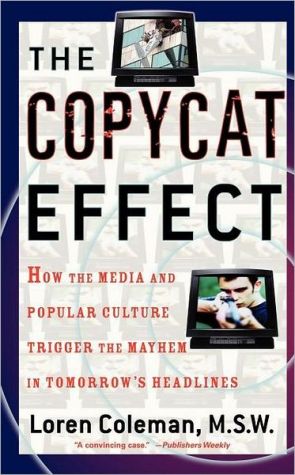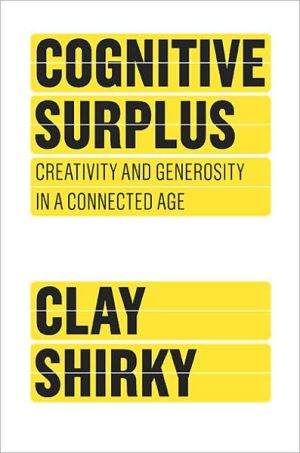The Copycat Effect: How the Media and Popular Culture Trigger the Mayhem in Tomorrow's Headlines
A disturbed student shoots up his classroom -- and suddenly a wave of mass murder is sweeping through our nation's schools. A young child is taken from her home -- and for months afterward child abductions are frantically reported on an almost daily basis. A surfer is attacked by a shark -- and the public spends an entire summer fearing an onslaught of the deadly underwater predators. Why do the terrible events we see in the media always seem to lead to more of the same?\ Noted author and...
Search in google:
A disturbed student shoots up his classroom -- and suddenly a wave of mass murder is sweeping through our nation's schools. A young child is taken from her home -- and for months afterward child abductions are frantically reported on an almost daily basis. A surfer is attacked by a shark -- and the public spends an entire summer fearing an onslaught of the deadly underwater predators. Why do the terrible events we see in the media always seem to lead to more of the same?Noted author and cultural behaviorist Loren Coleman explores how the media's over-saturated coverage of murders, suicides, and deadly tragedies makes an impact on our society. This is The Copycat Effect -- the phenomenon through which violent events spawn violence of the same type.From recognizing the emerging patterns of the Copycat Effect, to how we can deal with and counteract its consequences as individuals and as a culture, Loren Coleman has uncovered a tragic flaw of the information age -- a flaw which must be corrected before the next ripples of violence spread. Publishers Weekly According to Coleman, the media's attitude is "death sells... if it bleeds, it leads." The author, who has written and lectured extensively on the impact of media, mounts a convincing case against newspapers, TV and books that sensationalize murders and suicides, thus encouraging others to imitate destructive crimes. He traces the problem's roots to Goethe's The Sorrows of Young Werther (1774), which spotlighted a fellow who shot himself over a failed romance and inspired many young men to do the same. The novel encouraged widespread use of the term "the Werther Effect" when referring to copycat catastrophes. Coleman addresses Marilyn Monroe's 1962 death, pointing out that thanks to extensive coverage of the star's passing, "the suicide rate in the United States increased briefly by 12%." Other subjects include the 2002 Washington-area snipers John Muhammad and John Lee Malvo, whose actions spawned numerous sniper killings; suicide clusters among fourth-century Greeks; cult leaders Charles Manson and David Koresh, who attained gruesome glamour through melodramatic press perusal; Jack the Ripper-who created copycat killers from the late 1800s into the 20th century-and today's suicide bombers. Although readers may feel there's little they can do to muzzle media destructiveness, Coleman presents his advice to with enough punch to intrigue the public and possibly exert a minor influence on the press. (Sept.) Copyright 2004 Reed Business Information.
Preface: Window to the World\ You may vaguely remember the incident. It came over the television and radio as a "news bulletin." The dateline was Washington, D.C. The details, viewed in retrospect, are shocking.\ Frank Eugene Corder, who was immediately dubbed a "lone nut" by the media, had stolen a single-engine Cessna 150L plane from an airport north of Baltimore. He then headed south to the District of Columbia, flew over the National Zoological Park and down to the Mall, and apparently used the Washington Monument as a beacon. As he closed in on that Masonic obelisk just off the Beltway, Corder banked his plane into a U-turn over the Ellipse and flew low over the White House South Lawn, clipped a hedge, knocked some branches off the magnolia tree planted by President Andrew Jackson, and crashed the plane into the White House — two stories below the presidential bedroom. This all began at 2300 hours military time, according to the White House.\ There was an attack on the residence of the President and First Lady. And it happened not long ago. But few people today remember when the pilot of that Cessna launched his attack at the heart of our nation. It happened in 1994 — on September 11.\ Do you remember it? The incident obviously made quite an impact in the minds of some people. Coincidence? Conspiracy? Or something else?\ In the wake of Frank Corder's crash and the resulting publicity, the White House was the focus of a cluster of attacks. On October 29, 1994, Francisco Martin Duran, a convicted felon, pulled a semiautomatic rifle from under his trench coat and fired at least twenty-nine shots as he ran down the south sidewalk of Pennsylvania Avenue, spraying the front of the White House with bullets. In December 1994 the White House saw five incidents. Four of them involved breaches of the mansion's grounds and ranged from fence jumping, to threats of a bomb in a car, to a homeless man waving a knife on a sidewalk outside the White House. That individual was shot by police and later died of his injuries. Then, on December 17, an unidentified person fired at least four bullets at the White House. One went through a dining room window, while others hit near the president's bedroom window on the second floor.\ If you are surprised by the Corder story, you will likely be shaken by many of the other events recalled in this book. What is going on here? you wonder.\ In short, we are living in times strongly influenced by "the copycat effect."\ Copyright © 2004 by Loren Coleman
\ Publishers WeeklyAccording to Coleman, the media's attitude is "death sells... if it bleeds, it leads." The author, who has written and lectured extensively on the impact of media, mounts a convincing case against newspapers, TV and books that sensationalize murders and suicides, thus encouraging others to imitate destructive crimes. He traces the problem's roots to Goethe's The Sorrows of Young Werther (1774), which spotlighted a fellow who shot himself over a failed romance and inspired many young men to do the same. The novel encouraged widespread use of the term "the Werther Effect" when referring to copycat catastrophes. Coleman addresses Marilyn Monroe's 1962 death, pointing out that thanks to extensive coverage of the star's passing, "the suicide rate in the United States increased briefly by 12%." Other subjects include the 2002 Washington-area snipers John Muhammad and John Lee Malvo, whose actions spawned numerous sniper killings; suicide clusters among fourth-century Greeks; cult leaders Charles Manson and David Koresh, who attained gruesome glamour through melodramatic press perusal; Jack the Ripper-who created copycat killers from the late 1800s into the 20th century-and today's suicide bombers. Although readers may feel there's little they can do to muzzle media destructiveness, Coleman presents his advice to with enough punch to intrigue the public and possibly exert a minor influence on the press. (Sept.) Copyright 2004 Reed Business Information.\ \ \ \ \ Library JournalColeman (Bigfoot!: The True Story of Apes in America) discusses the tendency for people to imitate behaviors or events they see and how the mass media, which can demonstrably affect people's behavior, facilitate this tendency. Arranged thematically, this anecdotal collection covers incidents of death and destruction, with a few concluding recommendations for the industry to police itself. Coleman documents his barrage of anecdotal evidence through an extensive bibliography but does not offer an organized system of notes. He offers plausible support for his thesis by citing, e.g., suicide clusters, cult killings, and school shootings, but the section on copycat suicides in American baseball seems out of place. Coleman's argument contains a disturbing undercurrent regarding entertainment media, as when he faults The Deer Hunter for scenes involving Russian roulette. One is left wondering whether he wants to warn the public or sanitize art. Though a bit heavy for the general reader and lacking strong organization, this is really the only survey available on this topic, and larger public libraries and academic libraries should consider.-Audrey Snowden, John F. Kennedy Sch., Queretaro, Mexico Copyright 2004 Reed Business Information.\ \ \ Kirkus ReviewsSingle-minded examination of how violent and tragic behaviors tend to replicate themselves in our ultra-connected society. Social scientist Coleman has specialized in the phenomenon known as the Werther Effect, referring to the protagonist of Goethe's 1774 novel, The Sorrows of Young Werther, whose melodramatic suicide purportedly inspired widespread imitation. Today, Coleman fears "the power of mass communication and culture to create an epidemic of similar behaviors," citing the Werther effect and the contemporary concept of memes (ideas that replicate themselves like viruses) in combination with the saturation impact of mainstream films, video games, and trauma-centered nightly news. These and other media, he believes, bear unexamined responsibility for numerous unsettling phenomena. Devoting separate chapters to disparate events like sniper sprees, suicide via airplane, suicidal cults, post-office killings, and teenage suicide, Coleman finds that, in each case, frequently overlooked event repetitions over time likely influenced the most shocking, current iterations, such as the Muhammed/Malvo sniper attacks and 9/11. By carefully cataloguing long strings of traumatic events, the author offers persuasive and sometimes chilling evidence that murders and suicides often inspire imitation, as in the "suicide clusters" among seemingly normal teenagers that occurred in affluent and blue-collar towns alike during the 1980s and '90s. (Bolstering this theory, he also tracks suicide patterns among ballplayers, musicians, and Kurt Cobain cultists.) Coleman asserts that the media's tendency to emphasize "sensational stories of local violence," like school shootings, "feed[s] the copycat effectfrenzies." Other chapters explore such gruesome elements of crowd psychology as the magnetic attraction San Francisco's Golden Gate Bridge holds for potential suicides: one unofficial yearly average estimates nearly 300 attempts per year. The author's scolding tone, however, diminishes the persuasiveness of a text that concludes by offering seven suggestions to defuse the negative effects of "the major socially reinforcing element in the mix: the media itself."Adequate exploration of a theory that seems less than startling by the conclusion, thanks to undue repetition of its main points.\ \








